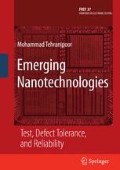Quantum-dot cellular automata (QCA) [16] may overcome some of the limitations of current technologies, while meeting the density foreseen by Moore's Law and the International Technology Roadmap for Semiconductors (ITRS). For manufacturing, molecular QCA implementations have been proposed to allow for room temperature operation; the feature of wire crossing on the same plane (coplanar crossing) provides a significant advantage over CMOS. Coplanar crossing is very important for designing QCA circuits; multi-layer QCA has been proposed [4] as an alternative technique to route signals, however it still lacks a physical implementation. At design level, algorithms have been proposed to reduce the number of coplanar wire crossings [9]. In QCA circuits, a reliable operation of coplanar crossing is dependent on the temperature of operation. Resilience to temperature variations due to thermal effects is also an important feature to consider for practical applications. A reduction in the probability of generating an erroneous signal is also of concern, hence, robustness must be addressed.
Access this chapter
Tax calculation will be finalised at checkout
Purchases are for personal use only
Preview
Unable to display preview. Download preview PDF.
References
S. Bhanja, M. Ottavi, S. Pontarelli, and F. Lombardi. Novel designs for thermally robust coplanar crossing in qca. IEEE Design and Testing in Europe, pp. 786-791, 2006.
S. Bhanja and S. Sarkar. Probabilistic modeling of qca circuits using bayesian networks. IEEE Transactions on Nanotechnology, 5(6):657-670, November 2006.
A. Fijany, N. Toomarian, and K. Modarress. Block qca fault-tolerant logic gates. Technical report, Jet Propulsion Laboratory, California, 2003.
A. Gin, P. D. Tougaw, and S. Williams. An alternative geometry for quantumdot cellular automata. J. Appl. Phys., 85(12):8281-8286, June 1999.
K. Hennessy and C. Lent. Clocking of molecular quantum-dot cellular automata. Journal of Vacuum Science and Technology, 19(B):1752-1755, 2001.
C. Lent. Molecular quantum-dot cellular automata. Seminar, May 2004.
C. Lent and P. Tougaw. Lines of interacting quantum-dot cells - a binary wire. Journal of Applied Physics, 74:6227-6233, 1993.
C. Lent and P. Tougaw. A device architecture for computing with quantum dots. Proceedings of the IEEE, 85(4):541-557, April 1997.
S. K. Lim, R. Ravichandran, and M. Niemier. Partitioning and placement for buildable qca circuits. J. Emerg. Technol. Comput. Syst., 1(1):50-72, 2005.
G. Mahler and V. A. Weberruss. Quantum Networks: Dynamics of Open Nanostructures. Springer Verlag, 1998.
M. Momenzadeh, M. Ottavi, and F. Lombardi. Modeling qca defects at molecular-level in combinational circuits. IEEE International Symposium on Defect and Fault Tolerance in VLSI Systems DFT 2005, pages 208-216, 2005.
P. M. Niemier, M. T. Kontz, M. J. Kogge. A design of and design tools for a novel quantum dot based microprocessor. In Design Automation Conference, pages 227-232, June 2000.
J. Pearl. Probabilistic Reasoning in Intelligent Systems: Network of Plausible Inference. Morgan Kaufmann Publishers, 1998.
G. Toth. Correlation and Coherence in Quantum-dot Cellular Automata. PhD thesis, University of Notre Dame, 2000.
P. D. Tougaw and C. S. Lent. Logical devices implemented using quantum cellular automata. Journal of Applied Physics, 75(3):1818-1825, Oct 1994.
P. D. Tougaw and C. S. Lent. Dynamic behavior of quantum cellular automata. Journal of Applied Physics, 80(15):4722-4736, Oct 1996.
K. Walus, T. Dysart, G. Jullien, and R. Budiman. QCADesigner: A rapid design and simulation tool for quantum-dot cellular automata. IEEE Trans. on Nanotechnology, 3(1):26-29, 2004.
Author information
Authors and Affiliations
Editor information
Editors and Affiliations
Rights and permissions
Copyright information
© 2008 Springer Science+Business Media, LLC
About this chapter
Cite this chapter
Bhanja, S., Ottavi, M., Pontarelli, S., Lombardi, F. (2008). QCA Circuits for Robust Coplanar Crossing. In: Tehranipoor, M. (eds) Emerging Nanotechnologies. Frontiers in Electronic Testing, vol 37. Springer, Boston, MA. https://doi.org/10.1007/978-0-387-74747-7_8
Download citation
DOI: https://doi.org/10.1007/978-0-387-74747-7_8
Publisher Name: Springer, Boston, MA
Print ISBN: 978-0-387-74746-0
Online ISBN: 978-0-387-74747-7
eBook Packages: EngineeringEngineering (R0)

